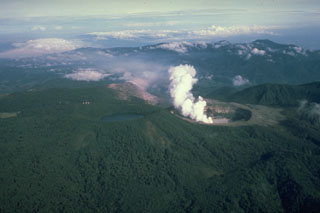Report on Poas (Costa Rica) — 21 May-27 May 2025
Smithsonian Institution / US Geological Survey
Weekly Volcanic Activity Report, 21 May-27 May 2025
Managing Editor: Sally Sennert.
Please cite this report as:
Global Volcanism Program, 2025. Report on Poas (Costa Rica) (Sennert, S, ed.). Weekly Volcanic Activity Report, 21 May-27 May 2025. Smithsonian Institution and US Geological Survey.
Poas
Costa Rica
10.2°N, 84.233°W; summit elev. 2697 m
All times are local (unless otherwise noted)
The Observatorio Vulcanológico y Sismológico de Costa Rica-Universidad Nacional (OVSICORI-UNA) reported continuing gas-and-steam emissions at Poás during 21-27 May; ash content of the plumes was either very low or not present. Sulfur dioxide gas emissions remained at high levels, though they had decreased compared to the previous week. The emissions detected in satellite data drifting SW on 20 May were estimated to be 598 tonnes per day (t/d). The fixed Differential Optical Absorption Spectroscopy (DOAS) station recorded slightly lower averages compared to the previous week, averaging around 309 t/d during 17-23 May, and a transect using a mobile DOAS instrument recorded 3,000 t/d on 22 May, similar to the previous week. Intense incandescence continued to be visible at both Boca A and Boca C vents. On 21 May the temperature at Boca A was measured with an infrared sensor mounted on a drone, revealing a maximum temperature of 470 degrees Celsius. Water continued pooling at Boca C. Pulses in acoustic data during 26-27 May likely originated from bubbling at Boca C. The volcano’s Alert Level remained at 3 (the second highest level on a four-level scale).
Geological Summary. The broad vegetated edifice of Poás, one of the most active volcanoes of Costa Rica, contains three craters along a N-S line. The frequently visited multi-hued summit crater lakes of the basaltic-to-dacitic volcano are easily accessible by vehicle from the nearby capital city of San José. A N-S-trending fissure cutting the complex stratovolcano extends to the lower N flank, where it has produced the Congo stratovolcano and several lake-filled maars. The southernmost of the two summit crater lakes, Botos, last erupted about 7,500 years ago. The more prominent geothermally heated northern lake, Laguna Caliente, is one of the world's most acidic natural lakes, with a pH of near zero. It has been the site of frequent phreatic and phreatomagmatic eruptions since an eruption was reported in 1828. Eruptions often include geyser-like ejections of crater-lake water.
Source: Observatorio Vulcanologico y Sismologico de Costa Rica-Universidad Nacional (OVSICORI-UNA)

